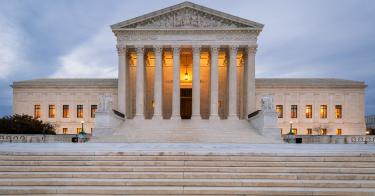Indian Tribes are unique entities. They’re sui generis (one of a kind) in American law. But from our country’s earliest days, our legal system has struggled with how to define their legal status. Are they foreign sovereigns? Domestic nations? Or something in between?
In one of the earliest formulations adopting the something-in-between approach, Chief Justice John Marshall famously described them as “domestic dependent nations.” Far from clarifying things, though, matters became only more muddled over the next two centuries.
Justice Clarence Thomas has said that “Federal Indian policy is, to say the least, schizophrenic. And this confusion continues to infuse federal Indian law and our cases.”
But now, the Lac du Flambeau Band of Lake Superior Chippewa Indians seeks to turn this confusion and the something-in-between approach to its advantage by claiming that because tribes are neither completely foreign governments nor completely domestic ones, they—unlike apparently all other governmental entities—are immune from suit for violating the Bankruptcy Code’s provisions. At the recent oral argument where the Tribe pressed its case, Justice Amy Coney Barrett said that it sounded like the Tribe was asking for “an extra super-special clear rule for [Congress to abrogate the sovereign immunity protections enjoyed by] Indian tribes.”
What’s happening here involves the interplay between two convoluted and complex areas of federal law: federal Indian law and the Bankruptcy Code with an overlay involving fundamental questions about the nature of sovereignty and sovereign immunity.
When Congress put in place the current Bankruptcy Code, it wanted almost all creditors and potential creditors to be part of the bankruptcy process. This makes sense. After all, the entire point of the process is to provide an orderly resolution or restructuring for debtors who don’t have enough assets to cover their debts. The Code establishes a complex interplay of rules and procedures for dividing or distributing the debtor’s assets. If one creditor can escape the bankruptcy process and satisfy its claim first, there might be nothing left for everyone else, and the whole process is defeated.
Necessarily, sovereign entities, which would ordinarily be immune from being haled into court, had to be part of this process too. So, Congress abrogated their immunity. The Supreme Court has said that while Congress doesn’t need to use magic words to remove an entity’s sovereign immunity, it must do so with a clear statement.
The Tribe argues that Congress included no such clear statement in the Bankruptcy Code for removing Indian Tribes’ sovereign immunity, even though Congress easily could have done so. And the Tribe points out that Congress has, in fact, clearly and unmistakably removed tribal immunity in various statutes by specifically referencing the tribes.
The Respondent here, Brian Coughlin (who is suing the Tribe for violating the Bankruptcy Code’s automatic stay provision), disagrees. He, along with the United States, argues that Congress did clearly abrogate tribal immunity. While Congress might not have used the specific magic words the Tribe thinks necessary, Congress tried to, as Justice Barrett said, “cover the waterfront” with this statute.
After all, the relevant provisions of the Bankruptcy Code, which Congress put in place, say that “Notwithstanding an assertion of sovereign immunity, sovereign immunity is abrogated as to a governmental unit . . .” for certain provisions of the Code.
And Congress clarified that the “term ‘governmental unit’ means United States; State; Commonwealth; District; Territory; municipality; foreign state; department, agency, or instrumentality of the United States (but not a United States trustee while serving a trustee in a case under this title), a State, a Commonwealth, a District, a Territory, a municipality, or a foreign state; or other foreign or domestic government.”
The case here focuses on this last phrase.
Coughlin and the United States both argue that regardless of precisely how Indian Tribes are categorized, surely the “other foreign or domestic government” language clearly encompasses them.
But the Tribe says not so because they are neither wholly foreign nor wholly domestic. Thus, Congress did not clearly include them in the abrogation language.
At oral argument, Justice Elena Kagan showed some slight sympathy for this position saying, “I mean, I agree with you that this looks like a trying-to-cover-the-waterfront statute. It just has this—this question, really, at the heart of it, like, if you were trying to cover the waterfront, why aren’t you listing tribes, which is, like, so much more obvious than all the things that they do list?”
Justice Brett Kavanaugh seemed intrigued by this question too.
But Justice Kagan also pointedly asked the Tribe’s lawyer, “. . . I think that the difficulty for you is, aren’t you really making it into a magic words requirement?”
Of course, the Tribe’s lawyer said no.
It’s important to note that all of this argument about abrogation takes place against a backdrop supported by tribal sovereign immunity itself. After all, if immunity doesn’t exist, there’s nothing to abrogate.
>>> Supreme Court Decides Half of Oklahoma Has Been an Indian Reservation for Past 113 Years
But as the Court has admitted, tribal sovereign immunity “developed almost by accident.” It’s a Court-created immunity that often traces its roots back to the early 20th century. But upon closer examination, the Court has said that the 1919 case often cited as creating this immunity “simply does not stand for that proposition” and “is but a slender reed for supporting the principle of tribal sovereign immunity.”
Nonetheless, principally for reasons of stare decisis, the Court has repeatedly reaffirmed the existence of such immunity.
More broadly, the Court has recently grappled with the questions of how much sovereignty tribal governments have actually retained. Justice Thomas has said in earlier cases that “the time has come to reexamine the premises and logic of our tribal sovereignty cases . . . In my view, the tribes either are or are not separate sovereigns, and our federal Indian law cases untenably hold both positions simultaneously.” He has also questioned whether Congress does in fact have plenary authority over the tribes as the Court has held because unlike the plenary authority Congress exercises over the District of Columbia or the Territories, which has a textual basis within the Constitution, he can find no such grant of authority for Congress over the tribes within the Constitution’s text.
Recent scholarship debates this point too, and the Court is grappling with it in another case it heard earlier this term but has yet to decide.
While it’s hard to predict the ultimate outcome of this case, it does seem odd that Congress would exclude tribes—and only tribes—from being amenable to suit if they violate important provisions of the Bankruptcy Code.
This piece originally appeared in The Federalist Society




